Gas too thin remains gas.
If it gets too dense collapses into stars
Jeans Mass -- gravitational attraction > thermal

Equilibrium / cycle
1 Msun/yr new stars
0.5-0.8 Msun /yr returned SN Heavy
Red Giants Element
O stars Enriched


gas in spiral arms has a high density, crashed in and becomes more dense. Star formation in young stars -- O stars in spiral arms
Basic energertics
HEATED by supernova ejecta shockwaves
COOLS by Bremstrahlung with lines
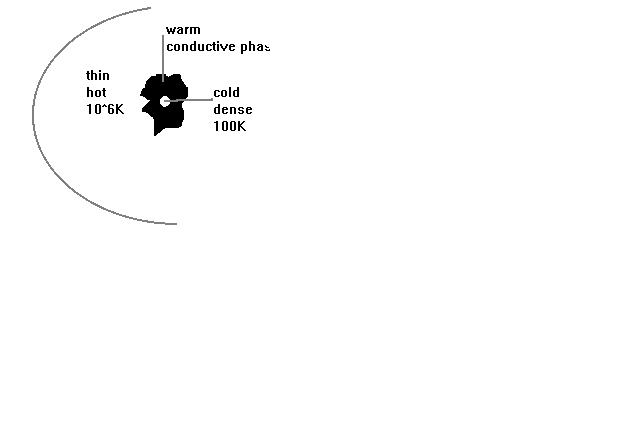 n1kT1=n2kT2
n1kT1=n2kT2
HOT -- x-rays (soft x-ray background)
WARM -- UV (can be seen in absorption, but not in emission)
COLD -- IR
Supernova Remnanats
SN explodes --> 2-10 Msun ejected at 3-10000 km/s
Energy released ![]()
Three Phases
1. Free expansion
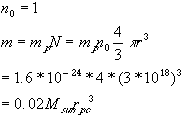
2. Adiabatic
sweeping up matter

gas heats up 106-107K
3. Snowplough (momentum conserving)
Radiates away its thermal energy through x-ray emission
Shock front gets lost in cloud motion
Equations of Growth
(n1 inside, n0 outside)
Pressure Equilibrium

x-ray sources:
non thermal radio (trapped high energy particles)
Cyngus Loop
The classic SNR
770 pc away
~20,000 years old
Veil Nebula

dense clouds optically emit, shocked by passage of waves
Very bright x-ray source
Interstellar Bubbles
10-5 Msun / yr V~2000 km/s
E after 10^6 years
![]() ~ 0.1 SN -- large!!
~ 0.1 SN -- large!!
Can affect ISM near star -- blow it away

When SN goes off -- 1051 ergs released
SNR control state of ISM: makes tunnels of very hot gas in warm and cold gas
BUT SN come for OB stars
OB stars come in clumps, therefore SN come in clumps
HII Regions
O star
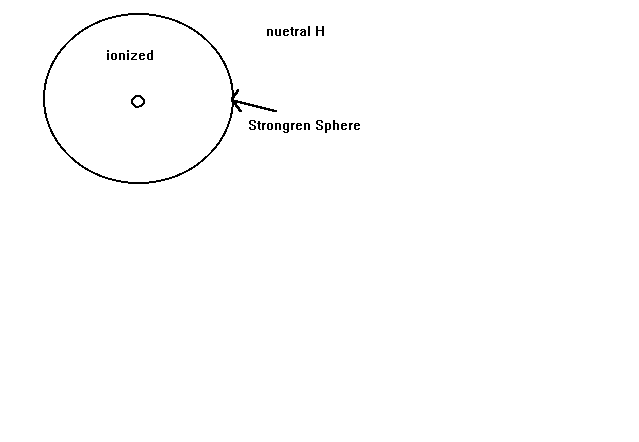
photon flux near star very high ionization rate > recombination rate
Radiates energy away through recombination lines Ha, Hb
forbidden lines [OIII]
Lya trapped, therefore IR source from dust
Gas between stars
galaxy started as gas
some left over
some reprocessed
Known for hundreds of years
HII regions
photon l < 912 angstrom, can remove electron for atom
OB stars generate lots of l < 912 angstrom light since OB young stars, are usually still in clouds they formed from
start with

turn on star, ionizes gas around star
Gas recombines, hits balance at some radius.
Ha is very strong, results in a red appearance of HII region
Next aspect of ISM was dust
Dust -- next aspect of ISM was dust
light does not need to be absorbed to make a star appear fainter. Like a sunset on a dusty day things appear redder. Blue is scattered more. Infrared is not scattered. IR is the only way to see center of Milky Way. Clearly activity is there -- IR will reveal it.
Molecular clouds
Very high density regions -- stars formed.
High density therefore radiates fast, therefore cold
T falls to 50-100K
Molecular form -- CO Seen in IR and radio
Clouds in less dense regions exist too. 21 cm emission
Can be seen by absorbtion spectroscopy
Molecular hydrogen
Hot gas --- OVI 300,000K gas
Lots of elements
Motion of gas -- 100 km/s
Supernova Remnants
Explosion sends out ~10 Msun at 10,000 km/s. Blast wave -- 1051 ergs. Same equation as effects of atom bomb in atmosphere.
Phase I: Expands freely, picks up all gas in its path
~100 years
~few parsecs
Phase II: Energy conserving, momentum also conserved. Slows down, but heats up.
1-10 million K --> emits x-rays
~20,000 years
~50-100 parsecs
Phase III: X-rays carry energy away
~1 million yearrs
Waves roll through ISM, interact with other SNRs
Phase IV: Breaks up and loses intensity
Structure of Milky Way
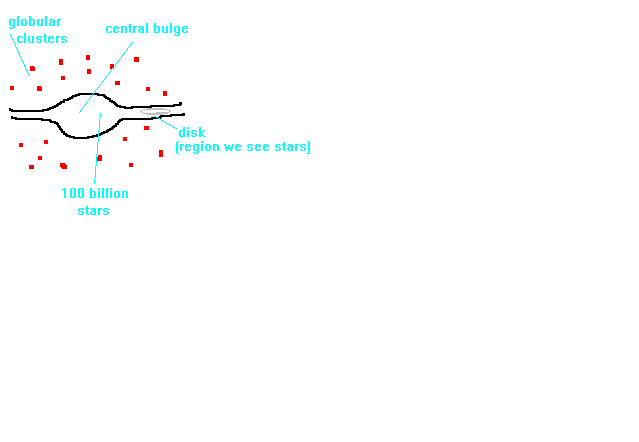
This basic picture is hard to put together. Can’t just count stars -- too may. We also can’t see all of them because of interstellar dust. WE could look at other galaxies, but we didn’t know what they were.
Globular clusters are bright enough to be studied over dust. This raises the question of how far away they are. We can fit them on the HR diagram.
Centered around point in Sag - 10 kpc away. This wa the first break in understandign the Milky Way.
We can see local arms, these indicate that we are in a spiral galaxy.
Radio Astronomy
No obscuration by dust
Karl Jansky -- first radio telescope. The first radio source is Sag A. -- galactic center.
21 cm line -- tracer of neutral Hydrogen. We can deconvolve this and map. In the 1960’s, for the first time, observers were abole to recognize spiral structure of galaxy.
Tracing the rotation outward, we see that there is a lot of mass. IN fact, most of the mass is in giant, invisible halo. This raises aquestion of what the halo is made of... neutrinos? baseballs? blackholes?
WE CAN NOT SEE MOST OF OUR GALAXY
Why is it spiral?

but would wind up too much.
Sun has time to go around 100 times, yet only several spirals -- it isn’t that simple.
Spiral arms -- density waves
Matter slows down, gas piles up --> prefered star formation.
It is OBA stars that light up spiral arms. Otherwise would hardly be able to see them.
Stellar generations:
galaxy formed first in middle.
more generations in center --> higher heavy element abundance
UV Astronomy
912-3500 (3500 --> optical)
Particularly 1200-2000 Angstrom
Why study UV?
Basic ground state transitions of the atoms
all ionizing potential 3eV < IP < 25 eV
most 4eV < IP < 14eV
If you can observe at 4-14 eV, will get fundamental data most notably Lyman alpha -- main line o f main elements 1216 A
Must be above atmosphere, but conventional optics work (just be careful)
1. Rockets Stellar Winds 1967
2. Copernicus High Resolution 1972-1980
3. IUE Spectrograph 1978-now
4. Space Telescope 1985
5. FUSE 900-1200 1990
Types of objects
1. O stars Photospheres
a) Stellar Winds
b) ISM in absorption
2. Late Stars -- Chronospheres
3. QSO’s
a) Emission Spectrum
b) Intergalactic Gas
Galaxies
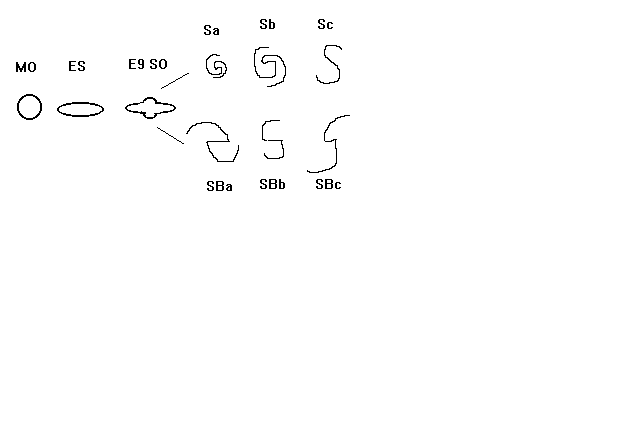
Self gravitating
Instabilities, perturbations excite spiral node.
Computer simulations --> much heavier for spiral, low mass stars in halo?
Clustering
Local group
Magellanic Clouds
Dwarf galaxies
M31, M33
Local Group
M31 Sb
Milky Way SBc
M33 Sc
Magellanic Clouds
1% mass of Milky Way
66,000 pc distant
Early type
HI stream -- orbits behind
30 Doradus
Dwarf Galaxies NGC 205, M32 orbit M31
Virgo cluster
falling toward it
x-ray source 10^8 K Bremsstrahlung
M87 supermassive galaxy
Missing Mass -- virial theorem vs mass/light
rotation curves
Super clusters
hierarchy of clustering
largest structure scal of universe
x-rays